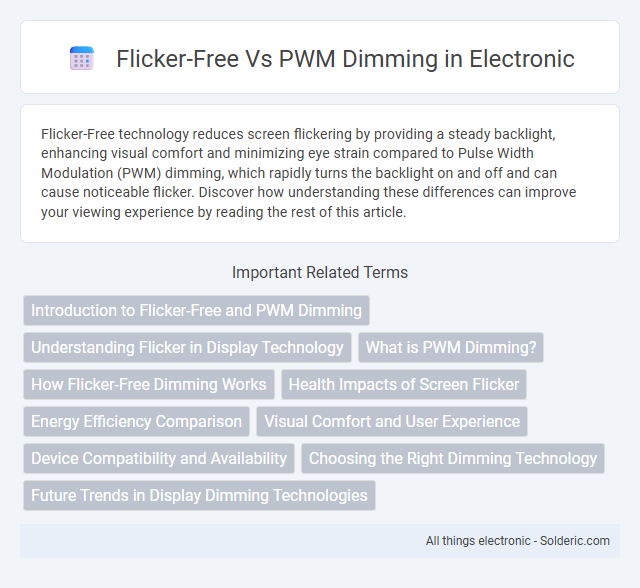Flicker-Free technology reduces screen flickering by providing a steady backlight, enhancing visual comfort and minimizing eye strain compared to Pulse Width Modulation (PWM) dimming, which rapidly turns the backlight on and off and can cause noticeable flicker. Discover how understanding these differences can improve your viewing experience by reading the rest of this article.
Comparison Table
| Feature | Flicker-Free | PWM Dimming |
|---|---|---|
| Definition | Constant backlight brightness without noticeable flicker | Brightness control by rapidly switching the backlight on and off |
| Health Impact | Reduces eye strain and fatigue | May cause eye strain, headaches, and fatigue |
| Technology | Uses DC dimming or stable backlight circuits | Uses pulse-width modulation to adjust brightness |
| Brightness Control | Smooth and stable brightness levels | Brightness level varies by duty cycle of pulses |
| Flicker Frequency | Not perceptible to human eye | Typically 60Hz to 500Hz, may be visible |
| Common Use | High-end monitors, eye care displays | Budget displays, cost-effective brightness control |
Introduction to Flicker-Free and PWM Dimming
Flicker-free technology eliminates screen flicker by maintaining a constant backlight, reducing eye strain and fatigue during prolonged use. PWM (Pulse Width Modulation) dimming controls brightness by rapidly switching the backlight on and off, which can cause noticeable flicker at lower brightness levels. Understanding the differences between flicker-free and PWM dimming is essential for selecting displays that prioritize eye comfort and visual stability.
Understanding Flicker in Display Technology
Flicker in display technology occurs when the screen's brightness rapidly alternates, often due to Pulse Width Modulation (PWM) dimming methods, which can cause eye strain and headaches. Flicker-Free displays use DC dimming or higher PWM frequencies to minimize this effect, enhancing your viewing comfort and reducing visual fatigue during extended use. Understanding the distinction between these dimming techniques helps you choose screens that maintain consistent light output without noticeable flicker.
What is PWM Dimming?
PWM dimming, or Pulse Width Modulation dimming, controls screen brightness by rapidly switching the backlight on and off at varying intervals. This technique adjusts the duty cycle of the light pulses to create different brightness levels, but can cause noticeable flicker at lower settings. Flicker-free technology eliminates this rapid switching, reducing eye strain and providing a more stable viewing experience.
How Flicker-Free Dimming Works
Flicker-free dimming works by maintaining a constant backlight brightness level through continuous current flow, eliminating the rapid on/off cycling typical of PWM dimming. Instead of pulse width modulation that adjusts brightness by rapidly switching the light source on and off, flicker-free technology uses a steady direct current to reduce eye strain and provide stable illumination. This method ensures smoother brightness transitions and enhances visual comfort during extended screen use.
Health Impacts of Screen Flicker
Screen flicker caused by PWM dimming can lead to eye strain, headaches, and visual fatigue, affecting user comfort during prolonged device use. Flicker-free technology reduces or eliminates these symptoms by providing a stable light output, minimizing flicker-related health issues. Choosing flicker-free monitors or displays contributes significantly to better eye health and productivity, especially for users who spend extended periods in front of screens.
Energy Efficiency Comparison
Flicker-Free displays often consume more power due to constant backlight operation, while PWM dimming adjusts brightness by rapidly switching the backlight on and off, improving energy efficiency. PWM dimming reduces energy usage by minimizing the duration the backlight is fully lit, making it more suitable for energy-conscious users. Your choice impacts power consumption, with PWM dimming generally offering better energy savings in low-brightness settings.
Visual Comfort and User Experience
Flicker-Free technology eliminates the rapid on-off cycles seen in PWM dimming, significantly reducing eye strain and headaches for users who spend extended periods in front of screens. Your visual comfort improves as flicker-free displays maintain consistent brightness without causing fatigue or discomfort. Choosing a flicker-free monitor enhances the overall user experience by delivering stable, smooth image quality that supports prolonged focus and productivity.
Device Compatibility and Availability
Flicker-Free technology ensures broad device compatibility by maintaining a consistent light output without rapid brightness fluctuations, making it suitable for monitors, laptops, and TVs across various brands. PWM dimming, which adjusts brightness through rapid on-off light pulses, is widely available but may cause eye strain or headaches on devices lacking advanced flicker reduction. Most modern premium displays prioritize flicker-free solutions to enhance user comfort, while budget or older models often rely on PWM dimming due to its simpler implementation.
Choosing the Right Dimming Technology
Choosing the right dimming technology involves understanding the differences between Flicker-Free and PWM dimming methods to reduce eye strain and improve visual comfort. Flicker-Free dimming uses a constant current to maintain screen brightness without rapid on/off cycles, while PWM dimming adjusts brightness by rapidly switching the backlight on and off at high frequencies. Your choice should prioritize Flicker-Free for sensitive eyes or prolonged screen use to minimize flicker-related headaches and discomfort.
Future Trends in Display Dimming Technologies
Future trends in display dimming technologies emphasize the shift from traditional PWM dimming toward advanced flicker-free solutions to reduce eye strain and improve visual comfort. Innovations such as DC dimming, hybrid dimming methods, and OLED panel advancements are gaining traction to provide more stable and consistent brightness control. You can expect these developments to enhance overall display quality and promote healthier viewing experiences in next-generation devices.
Flicker-Free vs PWM Dimming Infographic

 solderic.com
solderic.com